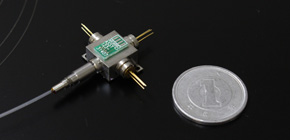
Two Types of RGB Laser Light Sources, Including a World-Class High-Brightness Model and an Ultra-Miniaturized Model, Successfully Demonstrated
Industry-University Consortium to Formulate Guidelines with the Aim of International Standardization and New Industrial Applications
As part of a NEDO project, Osaka University and Shimadzu Corporation have developed two new types of RGB laser light source modules, including a world-class high-brightness model and an ultra-miniaturized model, and demonstrated their effectiveness mounted on actual devices with the aim of expanding the application of visible light laser diodes.
In addition, an industry-university consortium coordinated by Osaka University has been established to develop guidelines for safety and related issues with regards to the new light sources. In the future, the consortium aims to promote new industrial applications by continuing activities related to practical use and dissemination of the technology, promoting awareness of the guidelines and supporting international standards development.

Figure 1. World-Class High-Brightness RGB Laser Light Source Module Implementation

Figure 2. World-Class Ultra-Miniaturized Model RGB Laser Light Source Module Implementation
1 . Overview
As part of a NEDO project * 1 , Osaka University and Shimadzu Corporation have developed two types of RGB (Red, Green and Blue) laser light source modules using RGB visible light laser diode technology. The first model (see image 1) realizes the world’s best-in-class brightness for use in high-brightness laser display devices * 2 and laser lighting * 3 , while the second model is the world’s smallest ultra-miniaturized model capable of single-mode fiber output * 4 for use in scanning-type laser displays * 5 (see image 2).
As a result of an evaluation of these modules by embedding them in devices from nine equipment makers * 6 , the lasers were shown to be superior in the categories of miniaturization, energy-saving performance, and color gamut compared to other light sources such as LEDs.
With the special characteristics of these lasers, we expect a wide range of potential applications from use in small-sized electronic devices such as smartphones and tablet devices to large video systems including theaters at the scale of tens of meters and projection mapping and aim to implement the technology in these devices.
Also, in order to address laser-specific challenges and safety issues that need be solved for practical use and dissemination of the technology, the Consortium of Visible Laser Diode Applications established by Osaka University (Photon Pioneers Center Vice Director/Specially Appointed Professor Kazuhisa Yamamoto) in 2014 recently developed performance standards and safety and reliability guidelines for RGB laser light source modules to provide the foundation for the application of visible light laser diodes. In the future, the consortium aims to promote new industrial applications by continuing activities related to practical use and dissemination of the technology, promoting awareness of the guidelines and supporting international standards development.
Glossary
*1 NEDO project
“Clean Device Promotion Project/Establishment of Infrastructure for Applications of Most Advanced Visible Laser Diode Devices”
Duration: FY 2014-2016
Contractors: Osaka University, Shimadzu Corporation
Project Leader: Photon Pioneers Center Vice-Director/Specially Appointed Professor Kazuhisa Yamamoto
“Clean Devices” are defined as advanced electronics devices that are very close to practical use and are expected to generate significant energy saving results once implemented in society.
*2 High-brightness laser display devices
Displays such as projectors or liquid crystal TVs that use laser light sources. Particularly with projectors, progress towards replacing traditional light sources with laser light sources is occurring rapidly
*3 Laser lighting
There are advancements underway toward the development of fluorescent white light sources based on fluorescence excitation using laser beam. A common example of this is lasers being used in headlights for vehicles. Automotive manufacturers in particular are currently working to make the technology ready for commercial use.
*4 Single-mode fiber output
“Single mode” refers to the combination of multiple frequencies of light into a single beam of light by constricting the distribution of light to a single point using a fiber with a small diameter core. When optical fibers guide light in this single-mode, it is referred to as a single-mode optical fiber. For visible light, the output is a laser beam created by a fiber with a very fine core with a diameter of 10μm or less.
*5 Scanning-type laser display
Examples of display devices that use scanning laser beams for projection include HMDs (head-mounted displays), HUDs (head-up displays), and portable projectors.
*6 Nine equipment makers
Honda R&D Co., Ltd., QD Laser Inc., Panasonic Corporation, Seiko Epson, Pioneer Corporation, IDEC Corporation, Mitsubishi Electric Corporation, Hitachi, Ltd., and Stanley Electric Co., Ltd.
For more information, please contact:
NEDO Electronics, Materials Technology and Nanotechnology Department
Contact Person: Kishida
Tel: +81-44-520-5211
Email: denzai@ml.nedo.go.jp
Osaka University Photon Pioneers Center
Contact Person: Tatsumi
Tel: +81-6-6105-5298
Email: phop5@ppc.osaka-u.ac.jp
Shimadzu Corporation, Device Department
Tel: +81-3-3219-5797
Email: sensor@group.shimadzu.co.jp
Related links (links in Japanese)
